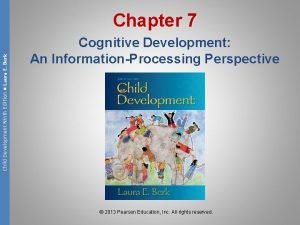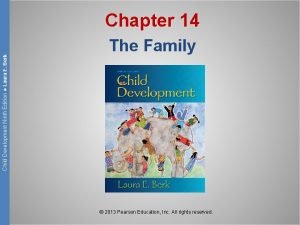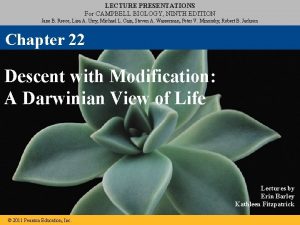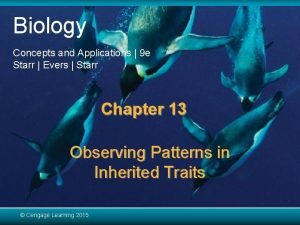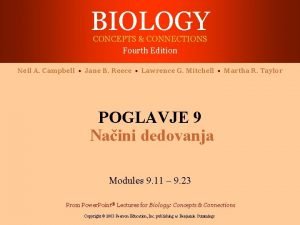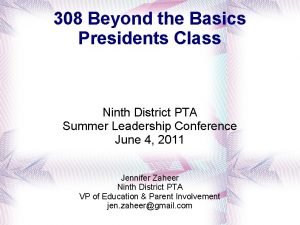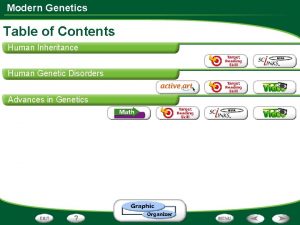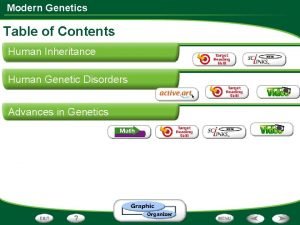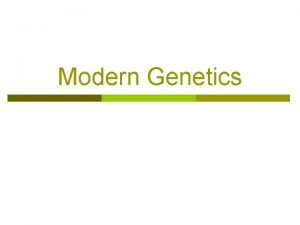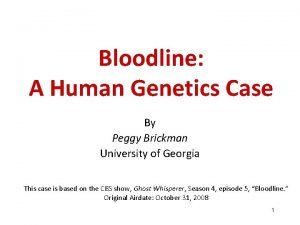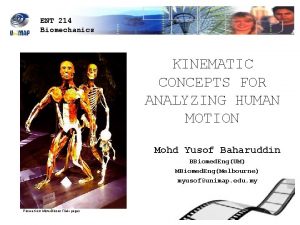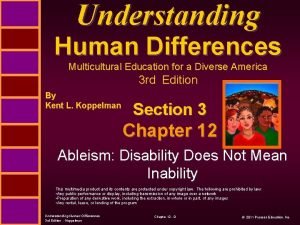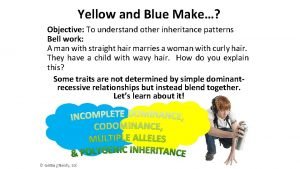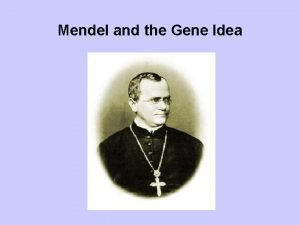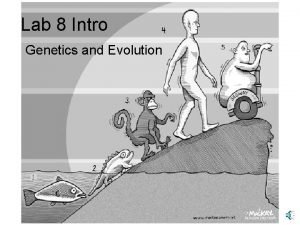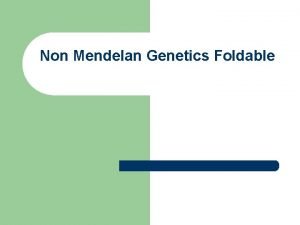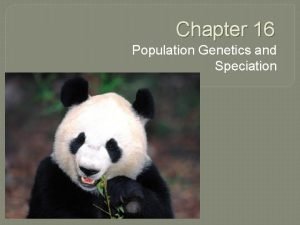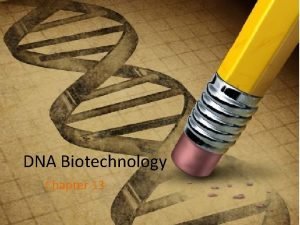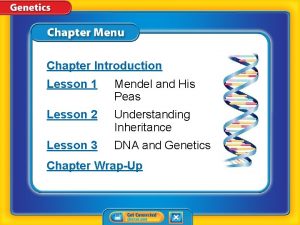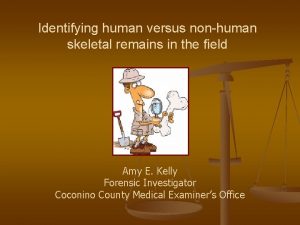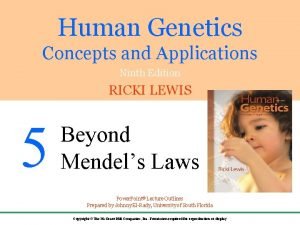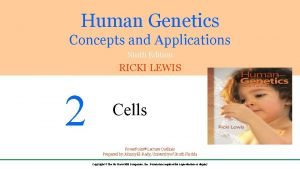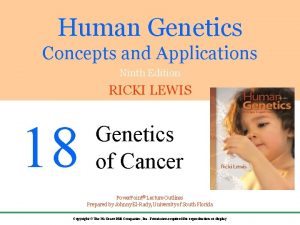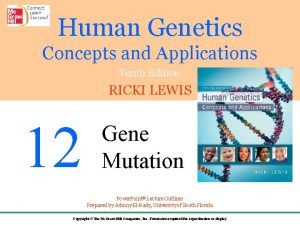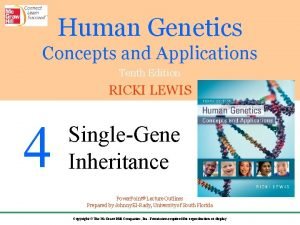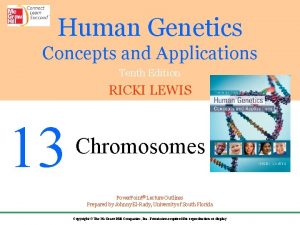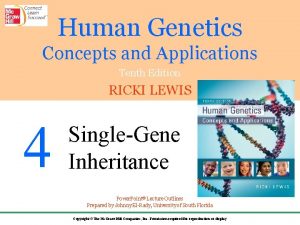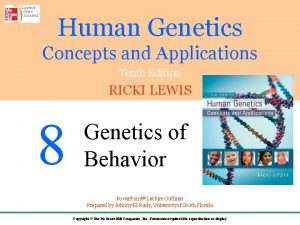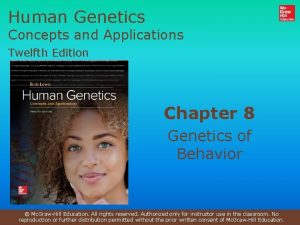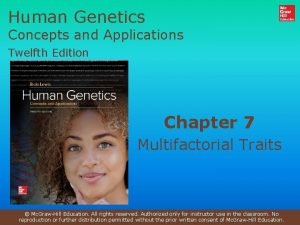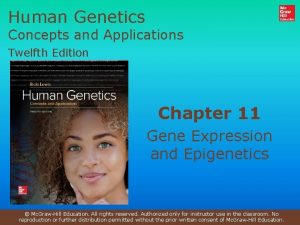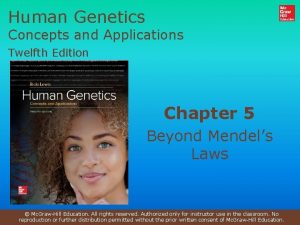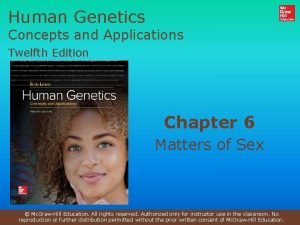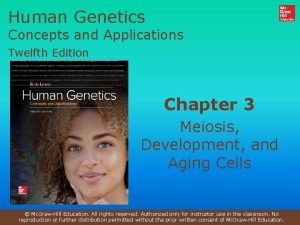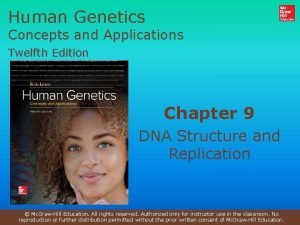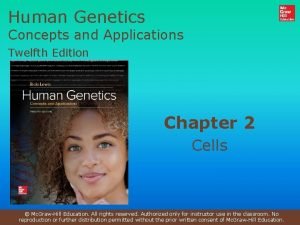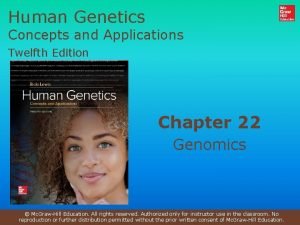Human Genetics Concepts and Applications Ninth Edition RICKI











































































- Slides: 75

Human Genetics Concepts and Applications Ninth Edition RICKI LEWIS 1 Overview of Genetics Power. Point® Lecture Outlines Prepared by Johnny El-Rady, University of South Florida Copyright ©The Mc. Graw-Hill Companies, Inc. Permission required for reproduction or display

Genetics Is the study of inherited traits and their variation Is a life science that should not be confused with genealogy Figure 1. 1 Is also an informational science that is having a huge societal impact 2

Genetics tests were once used solely to diagnose conditions so rare that doctors could not match a patient’s symptoms to a recognized illness. Today, taking a genetics test is as simple as ordering a kit on the internet, swishing a plastic swab inside the mouth, and mailing the collected cell sample to a testing company or research project. Example: Eve is curious about her ancestry and future health, so she finds a company whose test provide clues to both. Her DNA sample is scanned for variants inherited from her mother against a database of patterns of 20 nations and 200 ethnic groups near Africa. Eve learns that her family on her mother’s side came from Gambia. Eve must decide what test to dismiss as frivolous ( ear wax consistency ability to taste bitter food, blue eye color, baldness, obesity) Cancer and Alzheimer s disease are too remote for a 20 yr old to think about so she forgets those as well. Eve selects her health test based on her family history: she has a sister and father who suffer from respiratory infections. S/he asks for her DNA to be tested for gene variants that might affect breathing such as Cystic fibrosis, emphysema, asthma, lung cancer. Reluctantly she checks the boxes for heart and blood vessel diseases to. Her reasons are she can do something to reduce these risks. IS genetic testing something that you would do? 3

Inherited traits range from the obvious physical characteristics to many aspects of heath, including diseases. Talents, quirks, behaviors, and other difficult to define characteristics might appear to be inherited if they affect several family members, but may reflect a combination of genetic and environmental influences. 4

Some traits attributed to genetics border on the silly such as sense of humor or fondness for sports 5

History: Pythagonas (500 BC): proposed that “vapors derived from various organs united to from a new individual. Aristotle: Assigned a “vitalizing” effect to semen, which was highly purifed blood, influenced thinking for 2000 years. He believed that all inheritance came from the father and the mother merley provided the material from which the baby was made…this seemed to imply that all children ought to be boys he said that a girl was the result of interference from the mother’s blood 6

History: William Harvey ( 1578 -1657): Studied the development of chick embryos and was convinced that all animals must come from eggs EX ovo omnia: “out of eggs all”…. . he attempted to find mammalian eggs by dissection royal deer…he failed Oscar Hertwig: observed fertilization has union of single sperm and a single egg (16 th century) Spontaneous generation: the belief that life arose from none life…ex inject cucumber with sperm= miniture human. (17 th century) Late 17 th century: sperm and egg were discovered and a Dutch scientist: Swammmerdam: theorized that sex cells contained miniature adults, these theories continued into 18 th century. 7

History: 18 th century German investigator Wolff offered experimental evidence that no preformed embryos existed in egg of chickens. Charles Darwin (19 th century) proposed mechanism of his theory of Pangenesis: each body part produced minute particles (gemmules) which were contained in the blood of entire body, but eventually concentrate in reproductive organs…. Acquired characteristics would be inherited because as parts of body change, so did the pangenes they produced. Ex: champion weight lifter would produce children with strong arm muscles. Sir Francis Galton (1883 A cousin of Charles Darwin proposed the ideal of Eugenics, which was highly believed in and promoted by the Nazis during world war II. In 1907 US supreme court mandated the sterilization for “imbeciles, idiots, convicted rapists, and habitual criminals” 8

History: Ø 1927 Supreme court justice Oliver Wendel Homes wrote in favor of upholding these laws with the following: “It is better for all the world, if instead of waiting to execute degenerate offspring for crime, or to let them starve for their imbecility, society can prevent those who are manifestly unfit from continuing their kind…Three generations of imbeciles are enough. ” Ø By 1931 involuntary sterilization also applied to “sexual perverts, drug fiends, drunkards and epileptics” or anyone deemed feeble minded…. . this continued until 1940 s. Ø Eugenics is the idea to improve the human species by selective breeding. Positive eugenics refers to the promotion of breeding of those with favorable genes, (Nazi germans) and negative eugenics refers to the discourage or eradication of breeding among those with undesirable traits ( the jewish people) 9

Eugenics an effort to breed better human beings – by encouraging the reproduction of people with "good" genes and discouraging those with "bad" genes. 10

Eugenics The unfiltered story of American eugenics – primarily through materials from the Eugenics Record Office at Cold Spring Harbor, which was the center of American eugenics research from 1910 -1940 11

Eugenics You may find some of the language and images in this Archive offensive. Even supposedly "scientific" terms used by eugenicists were often pervaded with prejudice against racial, ethnic, and disabled groups. Some terms have no scientific meaning today. For example, "feeblemindedness" was used as a catch -all for a number of real and supposed mental disabilities, and was a common "diagnosis" used to make members of ethnic and racial minority groups appear inferior. 12

Eugenics I have made no attempt to censor this documentary record – to do so would distort the past and diminish the significance of the lessons to be learned from this material 13

Better Babies Contests At the beginning of the 20 th century, citizens concerned about high infant mortality in the United States took up the call of "baby saving. “ Better Babies Contests addressed this concern for child welfare and physical development, becoming the first eugenic competitions held at state fairs. The first "Scientific Baby Contest" to combine these standards was initiated by Mary De. Garmo in 1908 at the Louisiana State Fair. . 14

With the assistance of Dr. Jacob Bodenheimer, measures of contestants' physical and intellectual development were carefully recorded. Winning contestants often appeared in graduation gowns and were presented with "loving cups" to mark their achievement 15

Fitter Family Contests At most contests, competitors submitted an "Abridged Record of Family Traits, " and a team of medical doctors performed psychological and physical exams on family members. Each family member was given an overall letter grade of eugenic health, and the family with the highest grade average was awarded a silver trophy. Trophies were typically awarded in three family categories: small (1 child), medium (2 -4 children), and large (5 or more children). All contestants with a B+ or better received bronze medals bearing the inscription, "Yea, I have a goodly heritage 16

Fitter Family Contests Winners 17

18

Buck vs. Bell Trial In the Buck vs. Bell decision of May 2, 1927, the United States Supreme Court upheld a Virginia statute that provided for the eugenic sterilization for people considered genetically unfit. The Court's decision, delivered by Oliver Wendell Holmes, Jr. , included the infamous phrase "Three generations of imbeciles are enough. " Upholding Virginia's sterilization statute provided the green light for similar laws in 30 states, under which an estimated 65, 000 Americans were sterilized without their own consent or that of a family member. 19

Buck vs. Bell Trial The plaintiff of the case, Carrie Buck, and her mother Emma, had been committed to the Virginia Colony for Epileptics and Feeble Minded in Lynchburg, Virginia. Carrie and Emma were both judged to be "feebleminded" and promiscuous, primarily because they had both had borne children out of wedlock. Carrie's child, Vivian, was judged to be "feebleminded" at seven months of age. Hence, three generations of "imbeciles" became the "perfect" family for Virginia officials to use as a test case in favor of the eugenic sterilization law enacted in 1924. 20

Buck vs. Bell Trial Buck vs. Bell was flawed in many ways. "Feeblemindeness" is no longer used in medical terminology; it was clearly a catch-all term that had virtually no clinical meaning. It is impossible to judge whether or not Carrie was "feebleminded" by the standards of her time, but she was not patently promiscuous. According to Carrie, Vivian's conception was the result of Carrie's rape by the nephew of her foster parents. She, probably like many unwed mothers of that time, was institutionalized to prevent further shame to the family. Just as clearly, Vivian was no imbecile. Vivian's first grade report card from the Venable School in Charlottesville showed that this daughter of a supposed social degenerate got straight "As" in deportment (conduct) and even made the honor role in April, 1931. She died a year later of complications following a bout of the measles 21

22

23

24

Circus Performers Eugenicists were interested in various human disabilities, which they thought would give evidence to support theories of inherited characteristics. Though the performers in circus "freak shows" were intended as "curiosities, " eugenicists interpreted their disabilities as examples of degenerate heredity. They thought such people should be sterilized or prevented from marrying. 25

Race Mixing and Marriage Laws against interracial marriage had existed in some states since colonial times, but the number increased after the Civil War. Charles Davenport's compilation of State Laws Limiting Marriage Selection, in 1913, showed that 29 states had laws forbidding mixed-race marriages. Twenty-two states had stiff penalties for miscegenation — fines of up to $2, 000 and/or prison terms of up to 10 yea 26

German/Nazi Eugenics When Hitler came to power in 1933, he charged the medical profession with the task of implementing a national program in race hygiene. The first key element was the enactment, in 1934, of a law permitting involuntary sterilization of feebleminded, mentally ill, epileptics, and alcoholics. The "marriage laws" of 1935 prohibited unions between "Aryans" and Jews, as well the eugenically unfit. 27

German/Nazi Eugenics By the outbreak of WWII, in 1939, an estimated 400, 000 people had been sterilized. However, in 1940 the need for hospital beds for wounded soldiers prompted a "final solution" for "lives not worth living. “ Psychiatrists and medical doctors identified more than 70, 000 mental patients who were poisoned with carbon monoxide in extermination centers at psychiatric hospitals. 28

German/Nazi Eugenics After gassing of mental patients ceased in 1941, medical and other personnel with euthanasia experience were reassigned to concentration camps in Poland, where hydrogen cyanide gas was used to kill Jews, gypsies, Slavs, and Social Democrats. 29

History: German Biologist Weisman disproved pangenesis: he cut tail off mice for 22 generations, yet they continued to produce offspring with tails. 30

History: Gregor Mendel known as father of Genetics (1860 s): He worked with garden peas and developed 22 pure breeding lines from which he selected 7 lines for investigation He said that some factors will prevail over other factors. Today, we call these factors, Dominant ( prevailing factor) and Rececssive (non-prevailing factor). Mendel developed three basic laws that govern inheritance. 31

Law of Segregation: In the formation of gametes (sex cells) homologous chromosomes will separate, thus the genetic traits become separated. The chromosome number will be reduced from the Diploid (2 n) to the Haploid (n) number. Law of Independent Assortment: As the chromosomes separate, they do so in a random fashion; that is, they separate independently. Law of Recombination: Separated, haploid (n) gametes will unite at the time of fertilization, to return the chromosome number to the diplid (2 n) 32

Genetic traits are carried on in the nuclear structures called chromosomes. These traits are coded by nucleic acids (DNA) at different locations (loci) on the chromosomes, and we call these traits genes. Regular, one being contributed by the mother and the other by the father. We speak of these pairs as being Homologous chromosomes, because they carry genes for body cells have the diploid (2 n) number of chromosomes. 33

The chromosomes are in pairs the same genetic traits. IN most organisms there is one pair of sex chromosomes, the remaining chromosomes are called autosomes. Man has 46 chromosomes or 23 homologous pairs. 22 pairs are autosomes and one pair is the sex chromosomes. In most organisms, the female has identical sex chromosomes (XX) and the male has different sex chromosomes (XY). However in the case of fish, moths butterflies, , caddis flies and birds, the sexes are reversed. The male is XX and the female is XY. 34

Some terms useful in genetics are: Homozygous: Both factors on homologous chromosomes are the same. Heterozygous: Factors are different on homologous chromosomes. Genotype: Genetic makeup of the cell. Phenotype: Appearance…outward expression of genes. 35

CHARACTERISTICS USEFUL FOR EXPERIMENTAL ORGANISMS 1. 2. Variation: Organisms chosen should show a number of dectable differences. The larger the number of differing traits and the more cleasly marked they are, the greater the usefulness of the species for genetic study. Recombination: Genetic analysis of a species is greatly expedited if there exists some effective means of combining in one individual , traits of 2 parents. This permits comparison of one expression of a characteristic with another expression of the same trait. Recombination usually requires sexual reproduction of the test organism, but asexual reproduction may be used if specialized cells are of importance. By and large, a means of recombination is required for genetic study. 36

3. 4. Controlled matings: Choose parental lines with particular purposes in mind, and keep careful records of offspring through several generations. The study of human genetics has been largely dependent on pedigree analysis, or studies of traits in a given family line for several past generations. Short life cycles: Mice, which are sexually mature at 5 or 6 weeks of age and have a gestation period of about 19 to 31 days, are much more useful, for instance, than elephants, which mature in 8 to 16 years and have a gestation period of nearly 2 years. EX viruses which infect bacteria under optimal conditions, generation time is about 20 minutes 37

5. 6. large number of offspring: Genetic studies are greatly speeded up if the organism chosen produces fairly sizable lots of progeny per mating. Cattle, with generally one calf per breeding, do not provide nearly as much information in a given number of generations as would mice. Obviously, the larger the number of progeny, the greater the likelihood of detecting rare events. Convenience of handling: Whales are obviously less useful in this context than are bacteria. 38

METHODS OF GENETIC STUDY: 1. 2. 3. Planned breeding: in which parents exhibiting contrasting expressions of the same trait or traits are mated or crossed and careful records of results are kept through several generations. Pedigree analysis: used where controlled breeding programs are impossible. As is customary in pedigree diagrams, squares represent males, circles represent females. Statistical analyses: used to predict the probability of certain results in untried crosses and to provide degrees of confidence in a theory regarding the specific genetic mechanism operating in a given case. 39

Genes Contain the instructions within the cells for protein production Genes are composed of deoxyribonucleic acid (DNA) Traits are produced by an interaction between the genes and their environment Figure 1. 1 40

The Genome Is the complete set of genetic information for an organism It includes all of the genes present in an organism - And also DNA sequences that do not encode genes Genomics is a field that analyzes and compares genomes of different species 41

Levels of Genetics Figure 1. 2 42

Deoxyribonucleic Acid (DNA) A double-stranded polymer consisting of a chain of nucleotides Deoxyribonucleotide components: - Phosphate - Sugar: Deoxyribose - Base: Adenine A Guanine G Thymine T Cytosine C The sequence of the bases code for the amino acid sequence in a protein 43

Box, Figure 1 Reading 1. 1, Figure 1 44

Ribonucleic Acid (RNA) A single stranded polymer of ribonucleotides Ribonucleotide components: - Phosphate - Sugar: Ribose - Base: Adenine A Guanine G Uracil U Cytosine C Exists in several types Uses information on DNA to construct proteins 45

Box, Figure 2 Reading 1. 1, Figure 2 46

The Human Genome Only 1. 5% of our DNA encodes protein (called coding DNA) - About 20, 325 protein-encoding genes in all Rest of the human genome includes highly repeated sequences with unknown functionsand are called Noncoding DNA (junk DNA) Genes known to cause disorders or traits are cataloged in a database - Online Mendelian Inheritance in Man (OMIM) Proteomics is a field that studies the proteins made in a cell 47

Genes Alleles are variants of genes They form by mutation Mutations in sperm or egg cells are passed on to the next generation Mutations may be positive, negative, or neutral 48

Variations Polymorphisms are variations in the DNA sequence that occur in at least 1% of the population Single nucleotide polymorphisms (SNPs) are single base sites that differ among individuals - Can cause disease or act as genomic markers 49

Variations Genome-wide association studies track SNP patterns among individuals who share a particular trait or disorder Gene expression profiling measures which genes are more or less active in particular cell types 50

Chromosomes Composed of DNA and protein Found in the nucleus of the cell Human somatic cells have 46 chromosomes - 22 pairs of autosomes - A pair of sex chromosomes - Females have two X chromosomes - Males have one X and a Y 51

Karyotype A chart displaying the chromosome pairs from largest to smallest Figure 1. 2 52

Cells A human body contains approximately 50 -100 trillion cells - All cells except RBCs contain the same genome Differentiation causes cells to differ in appearance and function - Controlled by variation in gene expression Stem cells are less specialized and can become many different cell types 53

Levels of Biological Organization Figure 1. 3 54

Individual The genotype of an individual refers to the alleles they carry The phenotype is the visible trait A dominant allele is expressed if the individual carries just one copy A recessive allele is only expressed if the individual carries two copies 55

The Family Individuals are genetically connected into families A pedigree is a diagram used to study traits in families - Can be used to trace multiple genes or genes with large environmental component - Will be discussed in detail in Chapter 4 56

A Population Is a group of interbreeding individuals The gene pool is the sum of alleles in a population 57

Evolution Genome comparisons among species tries to reveals evolutionary relationships Humans share genes with mice, pufferfish, fruit flies, yeast, and even bacteria 58

Figure 1. 4 59

Mendelian vs. Multifactorial Traits Mendelian traits are determined by a single gene - Their recurrence is predicted based on Mendel’s laws Multifactorial traits are determined by one or more genes and the environment - Predicting their recurrence is much more difficult Most traits are multifactorial 60

Mendelian vs. Multifactorial Traits Figure 1. 5 61

Genes and Disease Risk Genetic determinism is the idea that the expression of an inherited trait is inevitable This may be harmful or helpful, depending on its application - As part of a social policy, it is disastrous - Knowing genetic risks can help us make good choices 62

Applications of Genetics impacts many areas of our lives DNA profiling (DNA fingerprinting) looks at SNPs and short repeated DNA sequences - It has applications in: - Forensics - History and ancestry 63

Forensics Identification of victims of natural disasters or terrorist attacks Matching the DNA of suspects to samples left at the crime scene Helping adopted individuals locate blood relatives 64

History and Ancestry DNA analysis can flesh out historical details - Revealing the offspring of Thomas Jefferson and Sally Hemmings - Revealing the origins of the Jewish Lemba of South Africa 65

History and Ancestry Figure 1. 6 Figure 1. 7 66

Health Care Pharmacogenomics is a field that identifies individual drug reactions based on genetics 67

Health Care Analysis of single-gene illnesses reveals many differences from other diseases 68

Health Care Diseases are increasingly being described in terms of gene expression patterns Tracking gene expression can reveal new information about diseases and show diseases are related to each other - This is not obvious via traditional medicine 69

The Diseasome Figure 1. 7 70

Genetic Testing and Treatment Tests to identify about 1, 200 single-gene disorders have been available for years - Direct-to-consumer (DTC) genetic testing The Genetic Information Non-discrimination (GINA) act was passed in the US in 2008 Genome information is useful for developing treatment to genetic and infectious diseases 71

Agriculture Traditional agriculture is the controlled breeding of plants and animals Biotechnology is the use of organisms or their parts to produce goods and services Genetically-modified (GM) organisms have new genes or over- or under-express their own genes 72

Ecology Metagenomics is a field that involves sequencing all of the DNA in a habitat - The Sargasso Sea - The Human Microbiome Project Metagenomic studies may be used to reconstruct ecosystems 73

A Global Perspective Genetics and genomics are spawning technologies that may vastly improve the quality of life Human genome information has tremendous potential for the entire globe - Individual nations are using approaches that exploit their particular strengths 74

A Global Perspective 75
 Human genetics concepts and applications 10th edition
Human genetics concepts and applications 10th edition Anatomy and physiology ninth edition
Anatomy and physiology ninth edition Psychology ninth edition in modules
Psychology ninth edition in modules Macroeconomics
Macroeconomics General adaptation syndrome
General adaptation syndrome Social psychology ninth edition
Social psychology ninth edition Biology ninth edition
Biology ninth edition Child development laura berk 9th edition
Child development laura berk 9th edition Child development 9th edition
Child development 9th edition Abnormal psychology ronald j comer 9th edition
Abnormal psychology ronald j comer 9th edition Psychology ninth edition in modules
Psychology ninth edition in modules Psychology ninth edition david g myers
Psychology ninth edition david g myers Biology ninth edition
Biology ninth edition Campbell ninth edition
Campbell ninth edition The sixth and ninth commandments
The sixth and ninth commandments The sixth and ninth commandments
The sixth and ninth commandments Starr evers starr biology concepts and applications
Starr evers starr biology concepts and applications Fluid mechanics fundamentals and applications 3rd edition
Fluid mechanics fundamentals and applications 3rd edition Biology concepts and connections 4th edition
Biology concepts and connections 4th edition Greek root light
Greek root light What is ramadan.
What is ramadan. William blount 9th grade academy
William blount 9th grade academy Lower ninth ward
Lower ninth ward French classical menu example
French classical menu example Ninth district pta
Ninth district pta Motivation from concepts to applications
Motivation from concepts to applications Human inheritance modern genetics answer key
Human inheritance modern genetics answer key Human clone
Human clone Modern genetics human inheritance answer key
Modern genetics human inheritance answer key 14-3 human molecular genetics answer key
14-3 human molecular genetics answer key Bloodline a human genetics case answer key
Bloodline a human genetics case answer key Susanna s epp
Susanna s epp Operating system concepts, 10th edition
Operating system concepts, 10th edition Operating system concepts 6th edition
Operating system concepts 6th edition Chords rule in dbms
Chords rule in dbms Using mis 10th edition
Using mis 10th edition Report
Report Endomysium
Endomysium Human anatomy and physiology 10th edition
Human anatomy and physiology 10th edition Mediolateral axis
Mediolateral axis Concepts of human values
Concepts of human values Understanding human differences 5th edition
Understanding human differences 5th edition Human resource management 15th edition
Human resource management 15th edition Gary dessler human resource management
Gary dessler human resource management International human resource management dowling 6th edition
International human resource management dowling 6th edition Understanding human communication 14th edition chapter 1
Understanding human communication 14th edition chapter 1 The art of being human 11th edition
The art of being human 11th edition Human resource management fifteenth edition
Human resource management fifteenth edition Adler and rodman 2006
Adler and rodman 2006 Indebtedness and deregulation in hrm
Indebtedness and deregulation in hrm Human anatomy fifth edition
Human anatomy fifth edition Human anatomy fifth edition
Human anatomy fifth edition Chapter 8 human needs and human development
Chapter 8 human needs and human development Chapter 8 human needs and human development
Chapter 8 human needs and human development Non human nouns
Non human nouns Yellow and blue make?
Yellow and blue make? Sexual reproduction and genetics section 1 meiosis
Sexual reproduction and genetics section 1 meiosis Pedigree miscarriage symbol
Pedigree miscarriage symbol Multiplication and addition rule genetics
Multiplication and addition rule genetics Similar
Similar Genetics is the study of heredity and variation.
Genetics is the study of heredity and variation. Chapter 22 genetics and genetically linked diseases
Chapter 22 genetics and genetically linked diseases Chapter 10 section 3 gene linkage and polyploidy
Chapter 10 section 3 gene linkage and polyploidy Genetics foldable
Genetics foldable Population genetics and speciation worksheet answer key
Population genetics and speciation worksheet answer key Chapter 10 sexual reproduction and genetics
Chapter 10 sexual reproduction and genetics Molecular genetics and biotechnology
Molecular genetics and biotechnology Genetics and biotechnology chapter 13
Genetics and biotechnology chapter 13 Altura de andrew garfield
Altura de andrew garfield Chapter 17 lesson 2 heredity and genetics
Chapter 17 lesson 2 heredity and genetics Human vs non human bones
Human vs non human bones Human development index definition ap human geography
Human development index definition ap human geography Heat and mass transfer fundamentals and applications
Heat and mass transfer fundamentals and applications Image sets
Image sets What is data and process modeling
What is data and process modeling Dfd chapter 5
Dfd chapter 5







